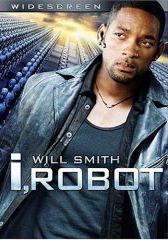
Arch
443/646: Architecture and Film
Fall 2007
I Robot (2004)
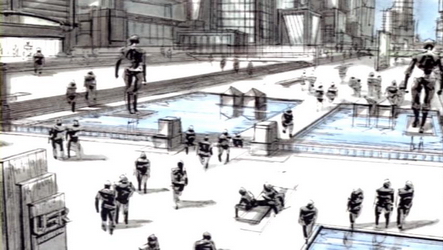
 |
Arch
443/646: Architecture and Film I Robot (2004) |
 |
Discussion Questions:
Remember, your images are ABOVE your name.
Please answer the questions below. Use paragraph form. Your answer should be around 400 words. Email me your responses in Word .doc format to: tboake@sympatico.ca I will be posting these each week after the class. You should be prepared to deliver your answer in class -- but paraphrase, do not read it. THINGS TO KEEP IN MIND WHEN ANSWERING THESE QUESTIONS: The director of iRobot made a conscious attempt to make his futuristic vision of Chicago more believable by layering and blending it into existing pieces of the city, recognizing that this is the way cities grow and evolve. Think of the idea of the "Uncanny Valley" when pondering Sonny. Bear in mind Freud's reference to vacuous or empty urban spaces as being uncanny - this in reference to the "unhomely" vs. the "homely". This theory being developed at the beginning of the Modern Movement when architecture had not yet been stripped of its "homely detail". Has the notion of the "haunted house" or the unheimlich changed at all with the evolution of clean modern architectural style? PLEASE READ EVERYBODY'S QUESTIONS BEFORE YOU ANSWER YOUR OWN. SOME HAVE BEEN PAIRED. DOPPELGANGER QUESTIONS ARE NOTED IN YELLOW... |
| 1. | 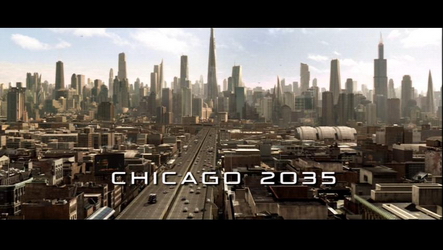 |
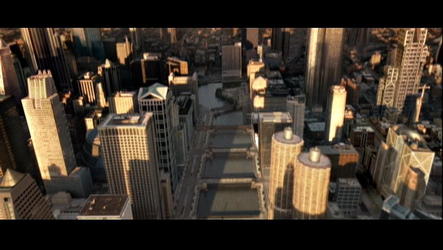 |
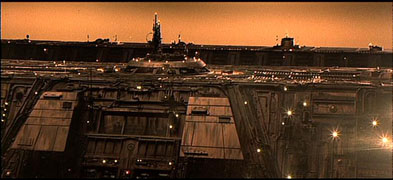 |
|||
Adam Brady The futuristic cities of Los Angeles and Chicago, in Blade Runner and I,
Robot respectively, are both set 30 years from their conception
and their vision are quite dramatic of one another.
|
||||||
| 2. |
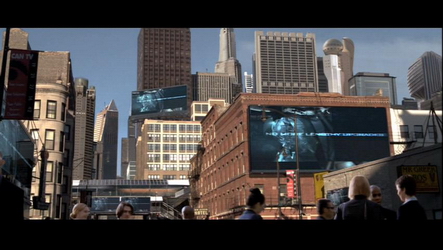 |
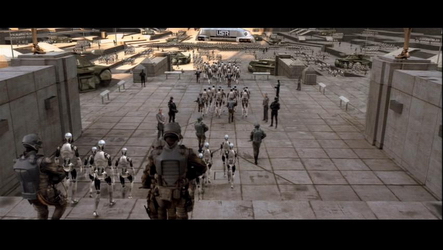 |
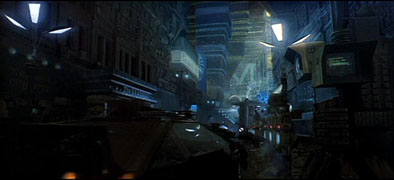 |
|||
Cassandra Cautius In Ridley Scott’s BladeRunner the depiction of Los Angeles is
dark, damp, and plays on immense rift in scale and vertical projection
through the city. Ground level here appears as if a sewer system, grade
is not the plane of green and growth but would appear as sub levels of
the city of the future. This dystopian future metropolis is lightyears
away from the backdrop set by Alex Proyas in his film; I Robot. Chicago
here is recognizable. The city structure we know today remains intact,
yet apparent on it is the skew and pull of time and progress. The skyscrapers
of our day are not engulfed in a brand new monstrosity of urban form
as would seem the case in BladeRunner, instead they are simply dwarfed
by the new towers of a new generation rising higher then previous logic
would allow. This is completely realistic and reflects the way in which
we today watch our cities grow slow and steady and upwards. It
would seem however that this is exactly the form of growth that would
countinue and eventually the city will find its inhabitants subsumed
in a new monstrosity the likes of which BladeRunner’s L.A. stands
as a fair warning.
|
||||||
| 3. | 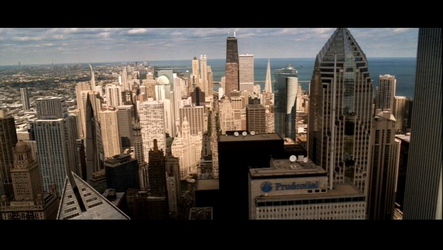 |
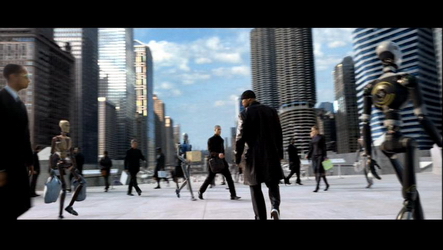 |
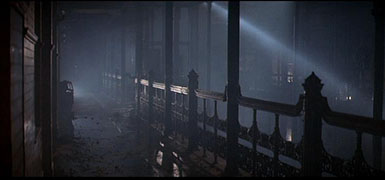 |
|||
Alexander Chan I believe that Proyas’ vision of the future Chicago is believable
because it offers a familiar yet distant possibility of the city’s
evolution. In other words the city is not that different from present
day however it still offers new and unique circumstances that currently
don’t exist. One approach that Proyas uses to interpret the future
environment is to add onto the existing urban elements like highways
superficial treatments to create new synthesis of old typologies. |
||||||
| x | 4. | 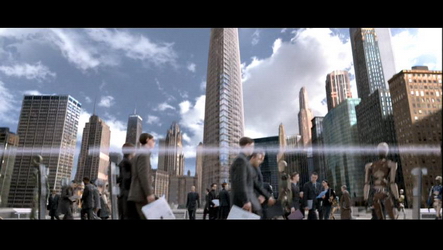 |
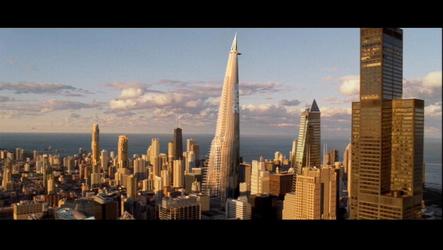 |
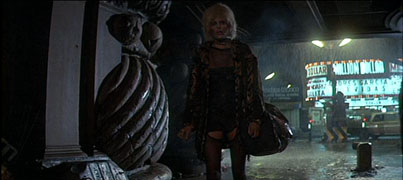 |
x | |
David Henderson Both Blade Runner and I, Robot use similar techniques
in the portrayal of the city of the future, yet they show quite different
possible futures. I, Robot shows a society very similar to our
own in a very recognizable city, whereas Blade Runner shows
an unfamiliar decaying world dotted with familiar objects and buildings
from the past. Speaking in terms of Dr. Mori’s theory of the “uncanny
valley” the robots in I, Robot are teetering at the first
peak on the human likeness graph while the replicants in Blade Runner have
already plunged into the depths of the uncanny valley. The cities in
these movies portray the feelings of people towards artificial beings,
one negative, one positive.
|
||||||
| 5. | 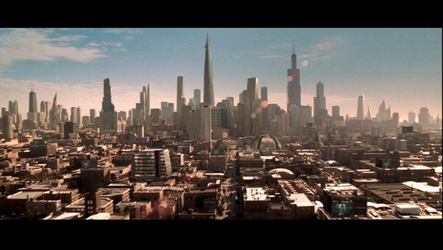 |
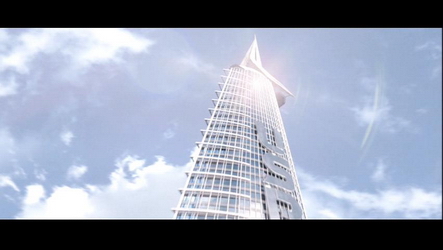 |
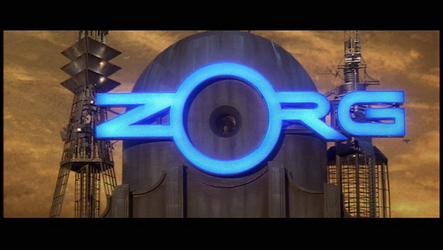 |
|||
Minwoo Lee The portrayal of the iconic towers in I-Robot and The Fifth Element
are very similar in many ways. The symbolic reference of power
and dominance in extreme verticality of the towers are clearly visible
in both movies. The dominance of the tower in the city’s
skyline portrays the hierarchical status of corporations in the city
functions. The world of the future that is characterized by control
and power exercised by the corporations, against which even the government
is incompetent.
|
||||||
| 6. | 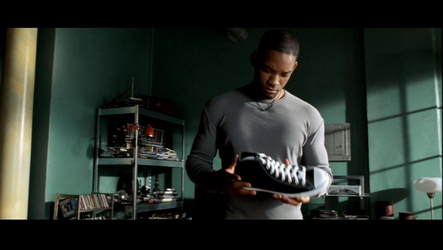 |
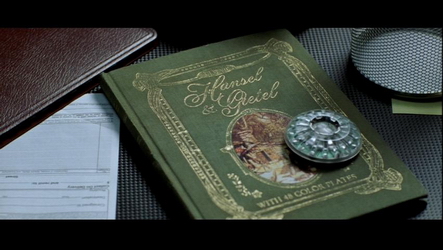 |
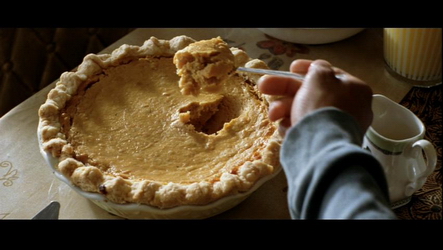 |
|||
Paula Lee The familiar objects of our time such as a sushi bar, boutiques and garbage trucks makes possible for the viewers to see future as another real living space by making the scenes more real as reality that we know presently gets projected in each scenery. In other words, these elements of present reality are utilized as a tool in the film to reduce the feelings of fear one might feel from a drastic change in future reality from present reality. Change is said to be a factor of fear for human, as change cause instability and possibility of an unknown outcome- disrupting the natural course. Even though the presentation of the movie’s setting seems definitely different from present cities, the use of these familiar places or objects reduce the amount of tension caused from the destruction of present reality in what film project as future reality. Personally, I feel these elements work really well in reducing the feelings of unfamiliarity of the unknown future cityscape. If the movie was made without these elements of nostalgia referring back to the viewer’s knowledge of reality, then it would have seemed hard to relate to and more uncanny as the connection between the viewer’s reality and futuristic scenes of the movie will be missing. |
||||||
| 7. | 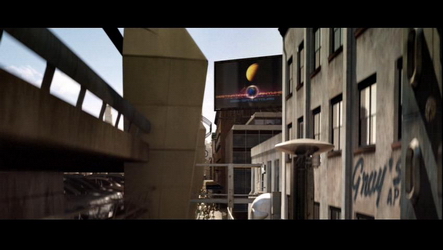 |
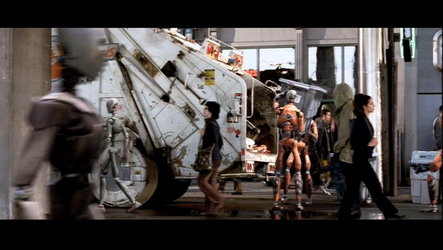 |
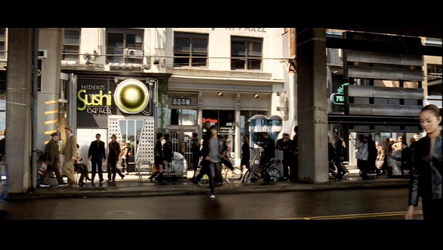 |
|||
Evelyn Lo The use of the existing Chicago streetscape in I Robot creates a more
believable future, as it portrays less of a dystopic world (as in Blade
Runner, Metropolis) and instead depicts a future that viewers recognize,
a future that does not so starkly contrast our own world of today. The
uncanny is the unsettling, disturbed feeling that comes from seeing something
that is familiar and recognizable and desperately striving to be 'real'
but fails to do so because of one or few distinct features that seem
'off'. The futuristic city of Chicago, however, does not fall under the
category of uncanny, as it appears comfortable, familiar, and thoroughly
realistic. There are no distinctly 'off' characteristics, and any element
of the future is softly blended into the city that they become nearly
imperceptible. |
||||||
8. |
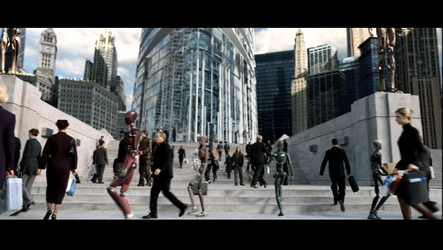 |
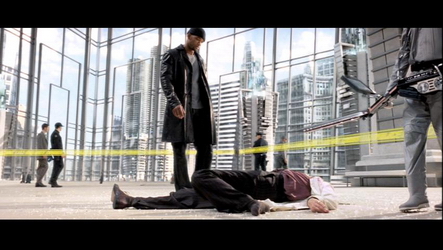 |
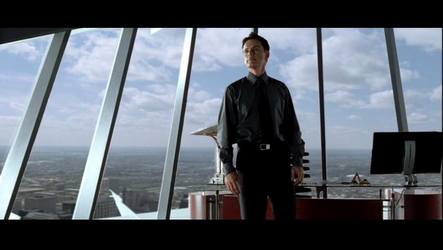 |
|||
John McFarlane Public prominence and the use of glass in buildings is often associated with transparent actions and accountability and can be used to convey the sense that the occupants of the building have nothing to hide from public scrutiny. From this position the siting and extensive glazing of the US Robotics headquarters contrast with the malevolent ambitions latent within it and this conflict of seeming good and being evil generates a feeling of the uncanny. Since the US Robotics company is largely comprised of good intentions, however, (Doctors Alfred Lanning and Susan Calvin and Lawrence Robertson are all revealed to be good people and only Viki can be seen as evil) the use of position and transparency could also be considered canny and appropriate. The development of more complex and less categorical characters in I, Robot compared to The Fifth Element’s Manichean stylization for example, doesn’t lend the film to a clear analysis on the basis of good and evil and makes the perception of what is uncanny uncertain. Neither reading is satisfactory from that position in any case because they oversimplify the meaning of glass in buildings. Transparency and reflections have been a central thread in architectural discourse since the beginning of the Modern Movement and the technical innovations that made walls independent of structure and therefore made the use of glazing more meaningful through the freedom of application available. The extensive use of glass in buildings can itself be seen as uncanny as illustrated by Jacques Tati in the confusion it creates for Monsieur Hulot and Barbara in Playtime and investigated through the dialogue on Mies van der Rohe’s Barcelona Pavilion:
The use of glass in its modern format – large expanses broken only by mullions – can be read as a manifestation of the uncanniness inherent in modernity. This position is the most effective from which to evaluate the US Robotics headquarters because that sense of the uncanny as a fundamental part of modern life is what the extrapolated realities proposed and morally explored by Isaac Asimov revolve around. The headquarters building is uncanny not because it looks friendly but because its glazing and position represent modernity in all its dualities. |
||||||
| 9. | 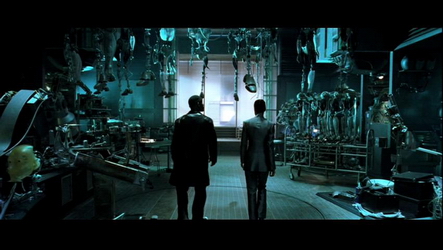 |
 |
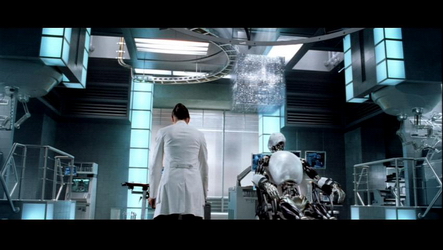 |
|||
Sava Miokovic The first image is of Dr. Lanning's laboratory. Robot parts and scientific instruments are scattered throughout the room. The room appears as a well-used workshop. The laboratory in Metropolis 1927 left the same impression. Although, the room is somewhat dark, it does not have the psychotic, disturbed atmosphere of the scientist's laboratory in Metropolis 2001. The laboratory in the last two slides seems to express societies greatest scientific achievement, the creation of life. This celebration occurs through the well-crafted space; having a strong materiality, organized and clean, and a luminous glow. The space is like a more advanced operation room in a hospital. This reference is made strong through the lab coat of Dr. Calvin, the colour palette, the silver tools, and the operating chair. This laboratory, like a hospital, is place were the threshold between life and death is encountered. The laboratory in the last two slides strongly references a church. Like a church, there is a strong symmetry and we enter along the central axis, framed by a colonnade, which is the glowing tower lights in this case. The alter is replaced by the operating chair, which traditionally lies below the dome, but in this case is replaced by the circle structure above, equivalent to the base of a dome, which allows light to flood down. A strong uplifting sense is created by this light in addition to the light towers adjacent to the operating chair, which are split, having the longer piece on the upper half, therefore drawing the eye up. The reference to the church plays up the feelings of the uncanny generated by the human creation of "artificial" life.
|
||||||
| 10. | 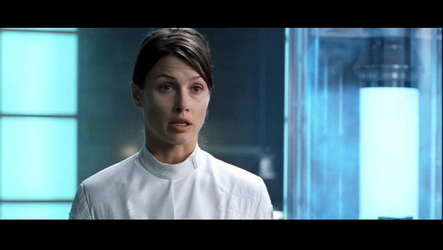 |
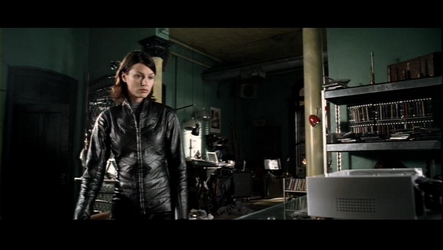 |
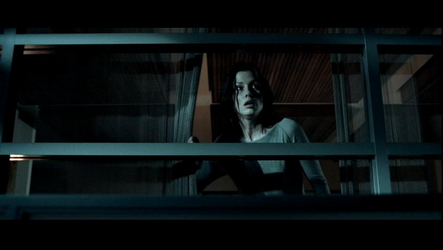 |
|||
Reena Mistry Dr. Susan Calvin plays an intrinsic role in developing the robots that define the uncanny nature of the film. As the “chief robopsychologist”, her logic is undeniably linked to the rationality and systematic operation and behaviour of the robots. The manner in which she recites information, her rational behaviour, even her perfect stance, portrays her character in almost a more mechanical way than the robots themselves. Sonny, though a robot, is sometimes much more human than Dr. Calvin. His curiosity and even his ability to trust and dream (revealed as the plot develops) can be starkly contrasted with Dr. Calvin’s portrayal (at the beginning of the movie) as an emotionally detached and purely rational scientist. When confronted with Agent Spooner, who suggests a robot was capable of committing a crime, Dr. Calvin is not only sceptical, but incapable of comprehending how programmed laws could be broken. According to the robot’s programming, the three laws make them incapable of harming humans. As a result, Dr. Calvin is more willing to trust a robot than a human. She relentlessly trusts her world of structure, rules, laws and control and though incredibly intelligent, she struggles to see and understand outside of this imprisoning paradigm. Essentially, human impulse, intuition, emotion, and even sense of humour are denied in her character and result in the disturbing notion that the producer of robots is even more robotic than the robots themselves. In many ways, Dr. Calvin’s close relationship to robots severs her relations with other humans. This is exemplified by her trust and respect for robots, affinity for Sonny, and obvious contrast with Spooner, who foils her character by his complete distrust and scepticism of robots. The greatest uncanny notion is that Dr. Calvin’s complete trust in the robots causes her to support their full integration into society; the mistake that society blindly makes that allows the robot revolution to occur.
|
||||||
| 11. | 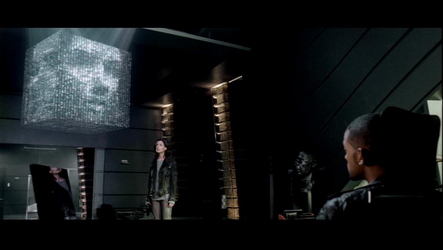 |
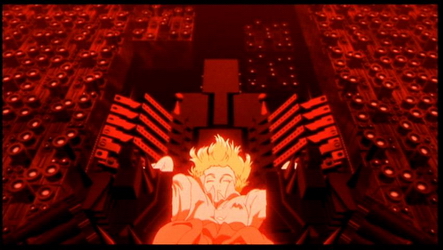 |
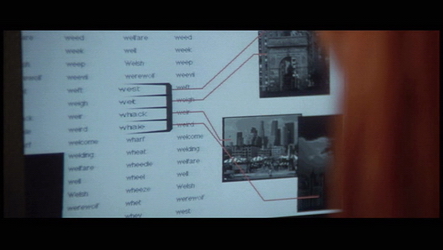 |
|||
Melissa
Ng The idea of the supreme robot presented in iRobot presents
a religious dimension as part of the film’s narrative. Viki
is seen as the supreme being, though humans are the true creators of
the robot race. This is evident in the robots’ allegiance
to Viki. The newly superior robots, which have been created to
be more ‘human’ than its predecessors, no longer respond
to serve their originating function as machines to assist the human race. Asimov,
the author of the original novel of which IRobot was loosely based, investigates
the ideas of robotic confusion during more complex situations. He
further elaborates that the solution to this confusion and difficulties
formed during crises may be eradicated with the ability to form an underlying
logic to evaluate the situation. This capability has been granted
to two robots in the film: Viki, the ‘supreme robot’ and
Sonny, who ultimately is not only the savior for the robotic race, but
for the human race as well. Viki’s logic causes her to override
the three laws or commandments imposed by humans in order to prevent
the self-destruction of the race due to the nature of man. Viki,
though seemingly flawless and almighty in its created intention, develops
to be the most flawed machine from them all; her incomplete capability
to understand the world and the human race inevitably leads her to deficient
reasoning showing her weakness to comprehend complex situations beyond
statistics. Her inhuman-like characteristics, both physical and
mechanical, contrasts with Metropolis 2001’s Tima and Fifth
Element’s Leeloo. Tima and Leeloo’s intended creations
were both to become the universal saviors of the human race – to
create a better place for all of mankind. Also, both ‘supreme
beings’ are designed as humans – they possess not only the
form of women, they hold the emotions as well. Furthermore, the
actions of these robots are the result of mans’ exertion – though
seen as ‘supreme beings’, humans still maintain control. Contrastingly,
Viki’s actions are the result of her own assessment and her aspiration
to save the human race from itself is one of which was made-up on her
own without human application. Furthermore, she is designed to
look like and act as a machine; a holographic image of a woman’s
face represents her existence. Sonny, on the other hand, is designed
much more closely to Tima and Leeloo. He is equipped with the
ability to learn, feel, and dream. His nature is reminiscent of
a true being, and his existence and function still remains honest to
his creator; he becomes a savior only as a result of his instilled purpose. The
most uncanny robot is Viki. Her role in the film is suggestive
of a classic Frankenstein story. The remarkable creation of man
ultimately brings destruction back unto the creator. |
||||||
| 12. | 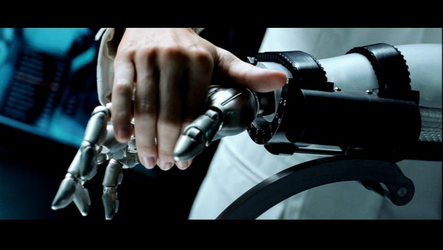 |
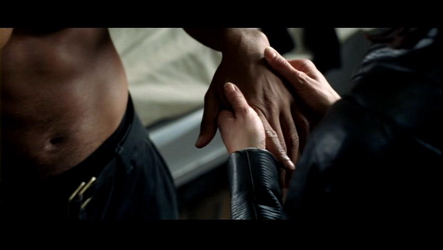 |
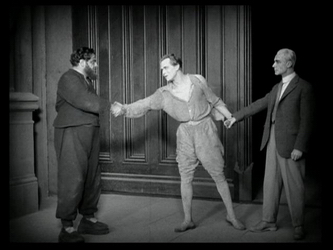 |
|||
Aisling
O'Carroll The development of the plot in Alex Proyas' I, Robot can be
clearly compared to Doctor Masahiro Mori's thesis on the Uncanny Valley.
Mori's theory suggests that the human emotional response towards objects,
whose appearances and movements are similar to that of a human, plunges
deeply into a repulsive response as the appearance and motion become
less distinguishable from that of a real human. As the appearance and
motions again become less distinguishable, the emotional response becomes
positive once more. In Proyas’ film we are initially presented
with a future Chicago, full of robots, yet seemingly harmless robots.
These early models appear to be constructed of metal bodies, similar
to the archetypal tin robots we are familiar with. This model inspires
little reaction, however quite soon into the film we are introduced to
the new NS-5 robot. This robot is a much more advanced model. The face
and parts of the body are formed with a translucent membrane, resembling
skin, while the legs and arms are connected with mechanics which look
like muscles and tendons. The face of the NS-5 is most notably similar
to that of a human; the eyes’ realism has greatly improved since
the earlier models, and the form of the face is much more realistic as
well. Our first encounter with the NS-5 is at the scene of Dr. Lanning’s
apparent suicide, so our natural reaction is to be apprehensive of it,
however, its appearance and seeming human features make the viewer much
more uncomfortable and distrustful. This reaction perfectly follows Mori’s
theory of the uncanny valley. As the robots become more human like, we
become more repulsed by them. As the movie progresses the NS-5s gain
more human characteristics, like the ability to override the Three Laws
of Robotics, engrained in their systems. The set of the film gets continuously
darker as the film progresses, significant to the idea of falling deeper
into the uncanny valley. At the deepest moment, when the NS-5’s
are working together as a mass revolting, the earlier robot models are
reintroduced in the scene at the waste site. These earlier versions now
inspire a sense of empathy as we recognise them as non-humans, without
human capabilities. At the end of the film, when Sonny explains that
he promised Dr. Lanning that he would do anything he asked, it becomes
clear that he was simply following orders, as he was programmed to do,
and not acting on his own in Lanning’s murder. This is the final
step in the journey down, and back out of the uncanny valley for the
viewer in Proyas’ film. Spooner, the main character, follows a
similar trail through the film, however he seems to be the only one who
experiences the uncanniness of the robots, which actually elevates the
sense of uncanny for the viewer. |
||||||
| 13. | 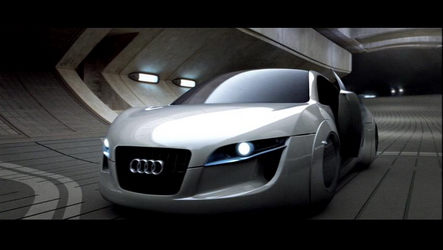 |
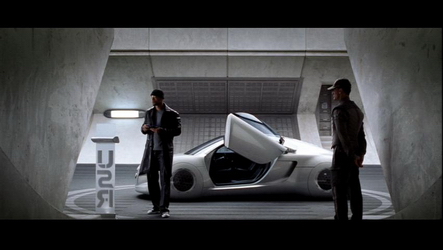 |
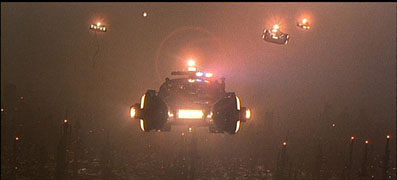 |
|||
Shannon Ross The automobiles used in iRobot seemed much more intelligently designed
than the police vehicles used in Blade Runner. They are much
more sleek and aerodynamic. In Blade Runner, the machinery of
the cars is exposed and they seem unfinished. The vehicles in iRobot
are more plausible as a representation of what the cars of the future
might look like because they show that they design intelligently when
they take into consideration the benefits of aerodynamics. Both
cars convey equally well the urban style of the city in which they are
placed. In iRobot, the sleek minimalist style of the city is reflected
in the design of the vehicles and similarly in Blade Runner the rough
and raw style of the city is reflected in their vehicles. |
||||||
| 14. | 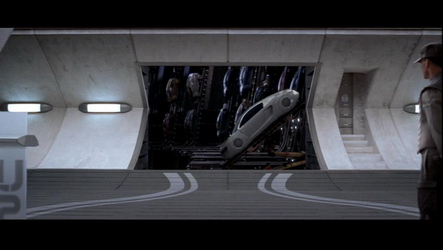 |
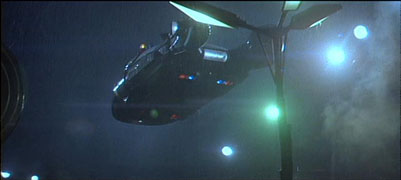 |
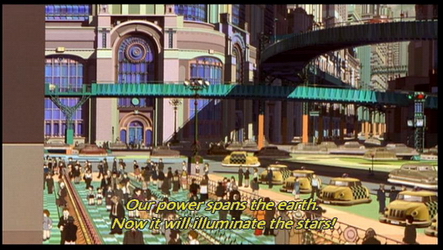 |
|||
Terry
Sin In all three films, I, Robot, Metropolis, and Blade Runner, urban space is represented in layers at enormous scales. However, by observing the relation between these spaces and the representation of vehicles, we are able to better understand the nature of these worlds. In both I, Robot and Metropolis, the cars hover in a futuristic manner near the ground, but never travel higher than a human being. This may be because the urban fabric is still firmly rooted in the ground. However, in both cases, there is also the presence of an extremely tall skyscraper that represents power, control, and wealth. The only way to travel vertically in these structures, is by being privileged enough to be part of the corporation. Thus, a regular person is still stuck to the ground. In Blade Runner, the urban spaces created by the Tyrell Corporation seem to be squeezed together, as though the great pyramids have forced spaces together at the human scale. The pyramids are also like a solid collection of skyscrapers with no infrastructure for transportation between them. This then relates to the necessity of actual “flying” cars, as it is impossible to travel in any other way. However, the only ones allowed to fly are the police, ones with control and power. Otherwise, the rest of the city is traveling on bicycles or regular wheeled cars. In all these cases, this hierarchy of power and altitude creates a sense
of the uncanny. It seems eerie that the only the privileged can travel
to the heights that humanity have reached in the future. In I, Robot,
the idea of the floating car seems unhomely, because it is so similar
to a actual car. It is a familiar brand (Audi) and has similar attributes
of a modern car, but floats lightly above the road. Furthermore, the
idea of the automated system of driving carries a sense on unease, with
a hint of even more danger without being in control. |
||||||
| 15. | 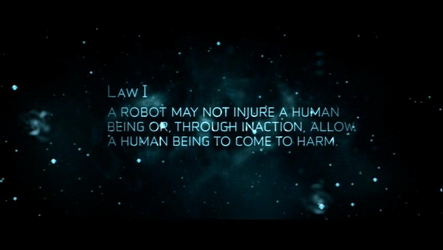 |
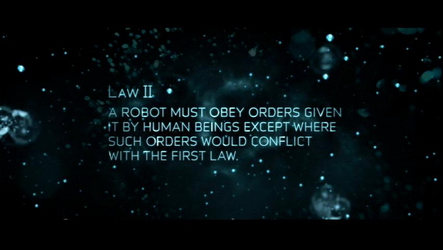 |
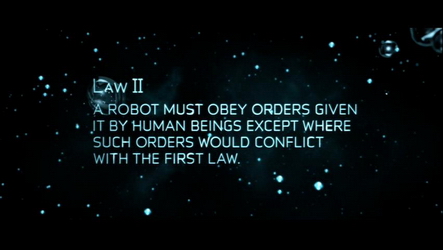 |
|||
Helen Tout Asimov’s three laws provide a framework for a feasible way to ‘control’ the
actions of robots in a hierarchal society where robots are the lowest
common denominator. Robots are stronger, faster and more capable for
accuracy than any human being and are therefore seen as a threat by some.
But most people in the I, Robot world trust robots implicitly because
of the three laws which they believe to be safeguards. |
||||||
| 16. | 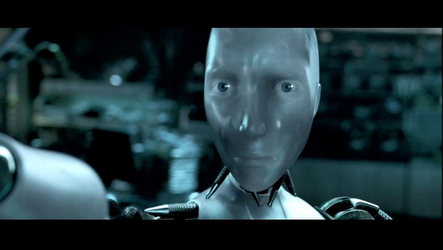 |
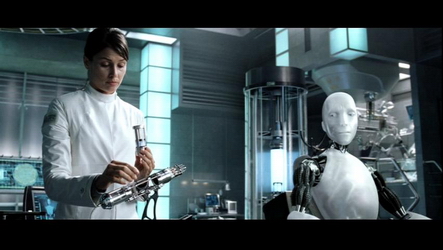 |
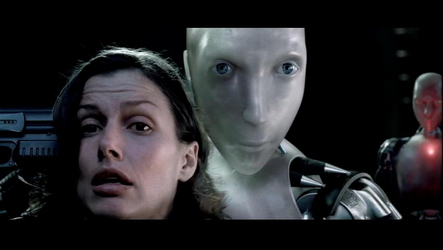 |
|||
Jamie
Usas I, HUMAN The film adaptation of Isaac Asimov's I, Robot, directed by
Alex Proyas (The Crow, Dark City), presents moments of android
to human interaction that question the nature of “Human” with
an honesty seldom achieved in science-fiction cinema. The robot, “Sonny” (Alan
Tudyk), while identical in appearance to all NS-5 model robots, persistently
blurs the line between humans and machines by subverting ideas of homogeneity
and conformity, paradoxically displaying human emotions such as anger,
fear, and love, all of which are uncommon to other NS-5 robots. Sonny
refers to himself by name, stating “I am Sonny” when addressed
by Detective Spooner (Will Smith), signifying a conscious understanding
of subjectivity and therefore individuality. Sonny, later makes
the distinction between uniqueness and commonness when speaking objectively
about himself with regard to the collective of NS-5 robots, stating “They
look like me [...] but they are not [...] me,” signifying his own
self-awareness. Sonny's individuality is first symbolized within
the narrative when he is hiding among hundreds of NS-5 robots [ Image
1] with the hopes of discouraging the pursuit of Detective Spooner, who
is threatening individual NS-5 robots at gun point. Spooner admits
that while most of the robots will not be threatened by his action, “one
will,” at which time Sonny reveals himself and confirms Spooner's
suspicion. This illustrates Sonny's individuality through both
Sonny's defiance of conformity, and Detective Spooner's anticipation
of Sonny's transgression. Later, when addressed by Calvin
before his scheduled deactivation [ Image 2], Sonny does not respond. When
questioned by Calvin for a reason explaining his unresponsiveness, Sonny
explains “I was dreaming”. Thus, Sonny approaches the
uncanny valley through his subjective relation of human experience. This
is the first moment that the robot speaks of human experience in a subjective
present tense (“I was dreaming”), rather than the objective
past tense, (“ I have had dreams”), implying that Sonny is
no longer relating the objective, passive idea of the dream, but specifically
the subjective act of dreaming. The juxtaposition of Sonny's non-human
form and hyper-human articulation creates a state of uncanny discomfort
in the viewer, and therefore progresses the viewer towards the uncanny
valley. Sonny pushes the viewer further into the uncanny by relating
his personal fear of death when asking Calvin “will it hurt?” moments
before she is to deactivate him, confirming a sense of his own mortality
and finite nature. The viewer is challenged to further question
the nature of “human” when Sonny successfully mimics a human
gesture in a moment of crises. While holding Calvin at gun point
[Image 3], Sonny signals Spooner with a wink, referencing the first encounter
between Spooner and Sonny, during his interrogation. During the
encounter Sonny had observed Spooner wink at another detective. Upon
Sonny's inquiry as to the meaning of the wink, Spooner replies “It's
a sign of trust. It's a human thing, you wouldn't understand.” The
reconnection to the first encounter between Sonny and Spooner, via Sonny's
wink, implies not only Sonny's understanding of “trust,” but
more importantly Sonny's very human invitation for Spooner to “trust” him
in a moment of extreme crisis. |
||||||
| 17. | 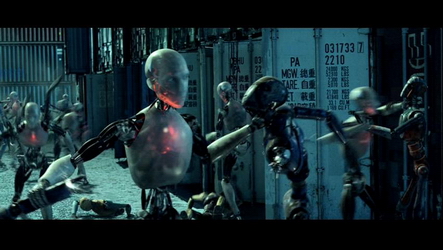 |
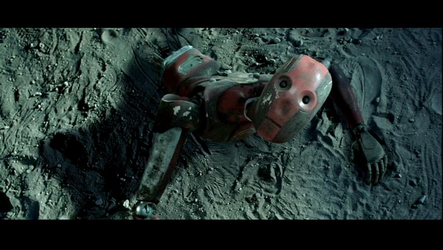 |
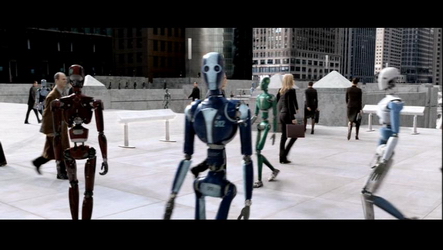 |
|||
Susan Varickanickal In the film “I Robot”, several types / styles of robots have been created to perform specific tasks for the members of society. As the design of the robots advance, new series of robots are created. This feeds into the idea that technology is always evolving, and that is was the robots are, species of technology. They were created as household appliances to aide domestic life; however, the advances in their design brought them new responsibilities, such as search and rescue, and other civic duties. The varying characteristics of the robots feed into the Uncanny by their ever-increasing roles in society. Their design make-up has rendered them efficient tools in carrying out specific duties in society, jobs that were once carried out by humans. Robots have now reached a new level of value, where their skills are more valuable than a human’s, replacing them in them in the work force. As technology evolves new species of robots are created that are more efficient and practical, which renders the older models unnecessary. In the film the older robots are seen being put into storage, as their services are now no longer needed with the advances in the newer models. The newer models are then shown destroying the older specie of robots. This interaction between the robots also feeds into the uncanny as they are seen in combat with each other, behaving in a human-like manner. They are at war with each other, both species expressing emotions and characteristics of humans. This idea creates the feeling of strangeness because these are only machines, and should be replaced over time with more efficient models; however, the battle between the robots creates a sense of strangeness in the human viewer as the robots behave in a more human-like fashion rather than as tools or machines. |
||||||
| 18. | 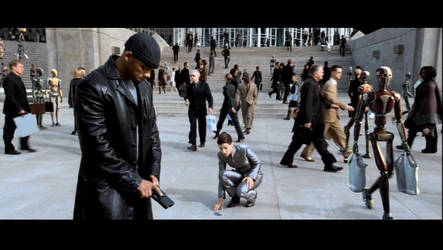 |
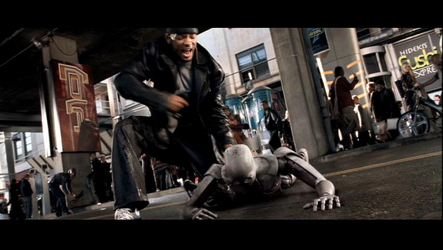 |
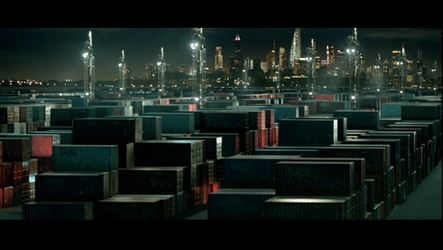 |
|||
Chao
Lun Wang With the development of computer graphics imagery, the scenes in I Robot has become much brighter than its early precedence, Blade Runner, which strategically uses a darker and rainy atmosphere to camouflage the crudeness of CGI in the 80s, which also explained why all the scenes are of the night. In contrary, Fifth Element, a more recent precedence to I Robot, has gotten much brighter. However the environment appears too surreal since it is done with scaled physical models that are rendered by studio lighting. There has also been a progression of cutting down on the set designs from earlier works to the more recent ones. Blade Runner used human-sized Hollywood sets to create much of its urban environment, while Fifth elements used scaled model with the green screen to render its urban environment, then in I Robot, computer graphics has totally replaced physical set-designs. The Architectural imagery of the exterior urban spaces in I Robot adapts the modern day buildings and structures and overlays layers of futuristic elements onto the scenes using a CGI technique that montages rendered graphics and lighting onto existing images of the city. This method to create an environment of the future suggests a possibility that an urban fabric of today being able to propel into the future. This is not the case for either Blade Runner or Fifth Element. In Blade Runner, the city of Los Angeles has been portrayed as a slum. Historical building has become abandoned while massive structures are erected in the hell-like fabric. While in Fifth Element, no real environment is used to render New York in year 2263. Everything is imaginary with no reference to anything that the viewer is familiar with. As an architect, watching I Robot while focusing on the exterior urban spaces suggests a sense of propelling permanence of our architecture into the future, and offer clues of how urban spaces designed nowadays can adapt to the technological development in the future. Conversely for the general public, they may find such rendition of the future not exciting, since many people who goes to a Science-Fiction movie would expect to see an urban space that is totally alien, and one that is more in-sync to the technologies portrayed in the film.
|
||||||
| 19. | 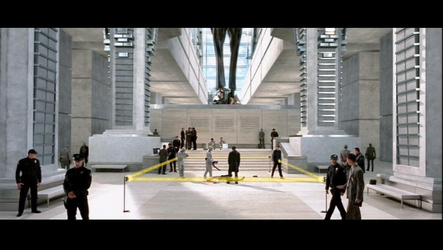 |
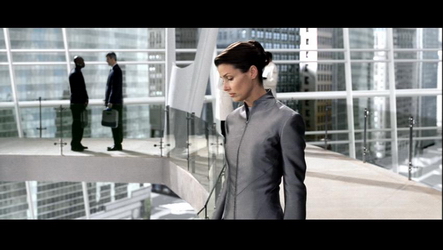 |
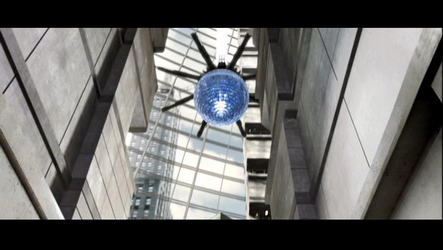 |
|||
Benjamin
Wong I, Robot portrays a modern world that, through some form of evolution, has still retained the feelings of the unhomely of Modern architecture. This is very much evident in the CGI architectural imagery of the interior spaces. The U.S. Robotics building, specifically, shows a sleek, modern building. It certainly functions impeccably well, operated by a computer, VIKKI, so that little or no human action is needed to regulate it. It even appears to provide for adequate sunlight to create a healthy work environment. What it lacks, however, is that homely feeling that answers to the metaphysical needs of living people. People need buildings that do more than look aesthetically pleasing and function well. Places such as Spooner's or Gigi's homes, where there is a clear lack of the technological advancements seen throughout the rest of the city, are the places that seem the most homely. In reference to the homely vs. the unhomely, therefore, the idea of the uncanny is produced. In comparison to the "traditional" techniques in Bladerunner and The Fifth Element, the technological advancements in graphics which made I, Robot possible seem to be much more effective in conveying the uncanny. Although each film portrays the future world fairly realistically by incorporating certain elements of the present world, the CGI in I, Robot was able to portray much grander gestures of a future architecture. They really allowed for an opportunity of the film to tap into the imagination of the audience, with the present as a basis for their inventions. "Architects" might certainly appreciate this aspect more than
the general audience, because of a different level of knowledge about
architecture. There is certainly a larger pool of knowledge on
the subject to tap into with the CGI graphics. At the same time,
the goal of these CGI graphics is really to create a certain atmosphere
by evoking set images of the mind. In this respect, perhaps it
is really not all that important how knowledgeable the viewer is of architectural
precedents. The same effect is achieved. Regardless, it is
certainly necessary for this level of realism and use of precedents in
order to maintain the integrity of this future world in the film. |
||||||
| 20. | 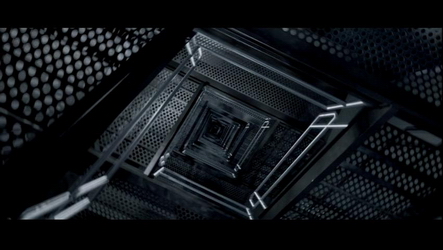 |
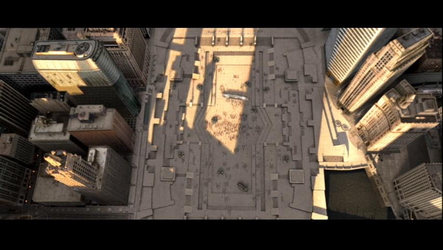 |
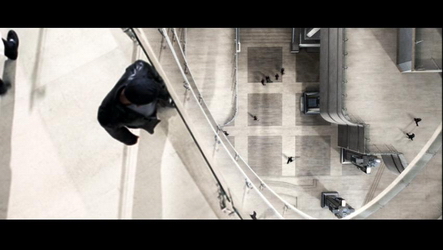 |
|||
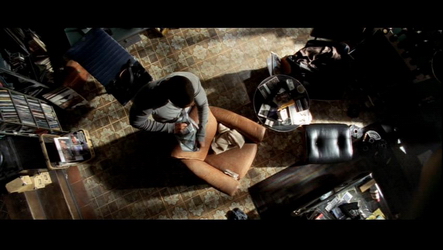 |
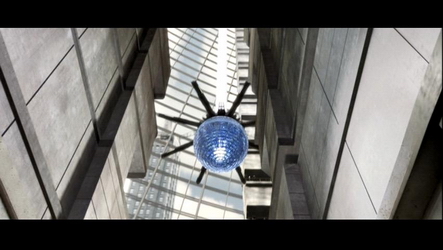 |
 |
||||
Erin
Corcoran Filming angles are often used within futuristic films as a way of demonstrating the impossible scale of the architecture of the urban environment of tomorrow. By using the angle of view to create vertigo-inducing views downwards from great heights, or dizzying views of dauntingly tall towers as viewed from the ground level, the film maker tries to give the viewer a sense of what it would be like to inhabit these environments, and also make a commentary on the inhuman aspect of the large scale of these projects. This technique, as employed throughout the film I Robot, is used to separate the human action elements from the over-designed perfect areas of the corporation’s headquarters. As the largest building in the city and the heart of the robot revolution, the USR building represents both the promise of the future and the ultimate failure of design that fails to take into account human function. The uncanny element within the film is the use of both scenes within the city displayed at the human scale (the grandmother’s house, streetscapes) and scenes within the futuristic USR zones. This forces the viewer to attempt to join together the parts of the city that they can most identify with with the portions of the city that seem most surreal or impossible. This juxtaposition of familiar and surreal as uncanny is also used within
Tezuka’s Metropolis as the characters transition from the various
zones into the city above, and within the Truman show as the setting
of the film begins as familiar and slowly develops into something unbelievable
but still meant to be accepted by the viewer as real. Like the
concept of the uncanny valley, the uncomfortable element is not present
by itself within either the artificial world or the familiar; it is present
within the transition, where the familiar and the impossible are so close
together but still so different as to be uncomfortable to the viewers
interacting with them. |
||||||
| 21. | 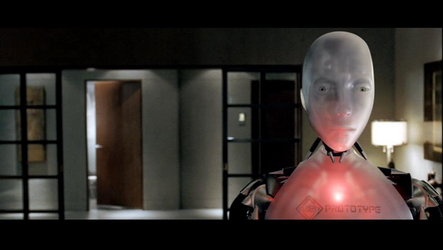 |
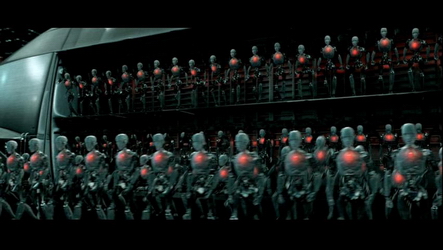 |
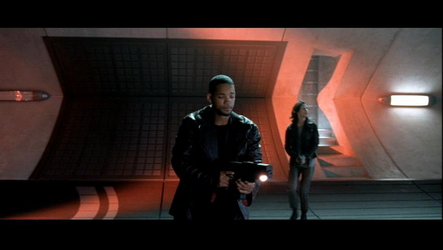 |
|||
Matthias
Heck Usage (or non-usage) of colors and lighting is an important aspect that helps creating different atmospheres in movies. One can see that clearly in Blade Runner, where a dark and shadowy environment necessarily leads to a desired gloomy and sinister atmosphere in the whole (film noir themed) movie. In terms of lighting, there is a big contrast between the intense neon lights and the all-embracing darkness in the cityscape of the future Los Angeles. In the interiors there is even less, spare lighting. This is a strong disparity to the Fifth Element, which is supposed to take place in a hip and lively world, hence the usage of loud colors, intense and bright lighting and consequently, more distinguishable materials and textures. I, Robot on the other hand, is more subtle in terms of lighting and colors, as it relies on discrete colors that blend in with the surrounding architecture. In the interiors more convenient white and light blue colors dominate (for example in the USR labs) with the exception of red alarm lights in a few scenes. Illuminated advertising using neon lights is a common urban and lighting theme in all mentioned movies. It stands out in Blade Runner due to the overwhelming presence of darkness and the sheer amount of product placement. I, Robot however has many daylight scenes and only few night shots, so we mostly see a sunlit cityscape of the future Chicago, which is characterized by a slightly modified skyline. The city basically appears to be an amalgamation of glass, steel and mainly concrete and shades of gray. This especially applies to the vast urban space in front of the USR building, which seems to be a heavy, monolithic concrete structure that acts as a contradiction to the surrounding "light" steel and glass high-rise buildings. In general, lighting and color is an aspect that does not stand out that much in I, Robot, so it feeds into the credibility of the shown utopia and the whole plot, as it seems more realistic and more believable. Hence, concerning the uncanny, the lighting in this movie largely works against an uncanny feeling, and there are only few exceptions: the activated robots that are under VIKI’s control for instance, have a red light on their chest plate, which evokes the association of a human heart. This particular association is especially uncanny in a certain way, as only the inhuman and menacing robots have that feature.
|
||||||
| 22. | 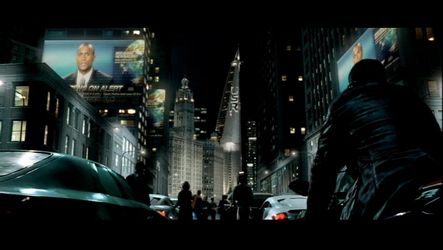 |
 |
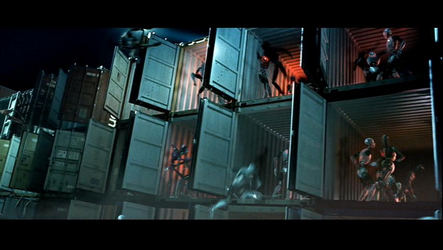 |
|||
Suzanne Gibson I Robot uses time of day to alter the feelings of space and time in the film, the use of both day and night shots helps to strengthens the believability of the movie and in doing so creates a greater sense of the uncanny. Of the futurist films seen so far in class I Robot is the only one that marries both night and day in the film, in comparison Blade Runners setting is dark while The Fifth Element takes place in bright ‘day’ like conditions. Although I Robot uses both day light and night conditions to tell a story, the quality of the environment also sets it apart from the other two movies. Blade Runner, uses a sinister darkness to betray a dark and unbecoming related, the environment of Blade Runner is wet, misty and perpetually dark. Darkness is typically associated with danger in part because darkness conceals potential dangers. The idea of darkness as a cover for the unknown can be seen in both movies, both Blade Runner and I Robot uses darkness and a means to conceal potential dangers. In I Robot everything evil happens either in natural darkness, or in the cover of artificial lighting in what would other wise be a dark condition, for instance the suspicious suicide of Dr. Alfred Lanning although not seen by the audience happened at night. Similarly detective Del Spooner takes a trip to the USR robot storage facility in the cover of darkness to discover that the NS5’s are destroying the other robots, and there Spooner access Lanning’s hologram, who explains that the three laws that govern robot behavior can only lead to revolution. Upon returning the city Spooner and the audience see that the robots have mobilized and are revolting against humans. Both of these scenes take place in darkness using the audience’s preconceived notion of darkness to enhance the feelings of discomfort. The only major action scene that does not take place in natural darkness but rather artificial light is the scene where Spooner is traveling in an underground tunnel, where his vehicle is boxed in by several USR trucks that then open and armies of NS5’s jump out and begin attacking his car. This scene lit by fluorescent lights, takes advantage of the dark shadows formed in the tunnel emphasizing the contrast between light and dark, making the scene as uncomfortable to watch as the night shots. Unlike Blade Runner, I Robot also takes advantage of day lit scenes. The Fifth Element, which is shot almost entirely during the day, uses highly stylized lighting that is too bright to be considered natural; it is the unnaturalness of lighting that causes feeling of discomfort. Unlike The Fifth Element, I Robot uses daylight to calm and create feeling of recognizable reality, although despite the attempts to mimic reality it should be noted that skies are too perfect and unmoving, both being static. Day light is used as a pause in the action, it is used as a time to reflect on the nights events, as seen at the end of the move as the revolution is being cleaned up and the events that lead up to the revolution have become understood. I feel that the reason the director of I Robot diverged from the pervious examples is that there was a desire to create a reasonable and believable reality the audience would be able to relate to. By having a believable reality the visual effects and story line become inscribed in a time and space, despite the potential for them being far fetched they can be related to in a way that is understandable. The other two movies are very different from I Robot, both the directors of Blade Runner and the Fifth Element chose not to create environments that could easily relate to the audience, in both movies the change of the environment is as much a part of the future as is the technologies that are presented in the movie. |
||||||
| 23. | 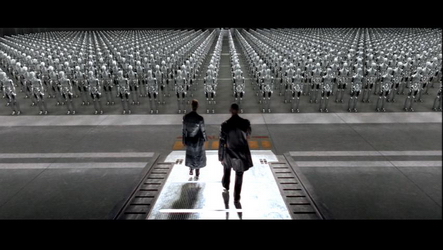 |
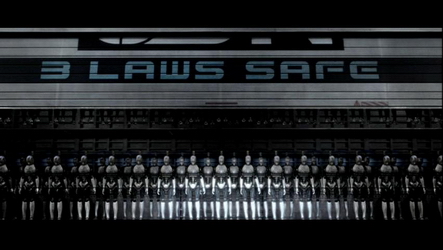 |
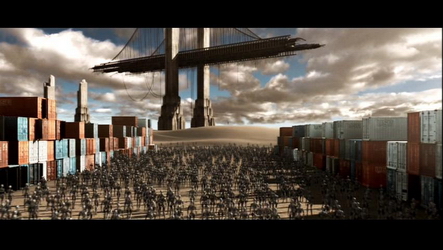 |
|||
Kate Gould In the movie I-Robot there is a particular feeling of the unhomely or
uncanny in their portrayal of large empty urban spaces, which leave the
individual feeling small and uncomfortable. In these spaces a feeling
of , the opposite of claustrophobia,
could be experienced where the individual completely looses themselves
in the crowd. Freud referred to empty urban spaces as being uncanny,
as they remove any real sense of the individual. This feeling of
anonymity in the public realm is central to the architectural language
and character development in the film I-Robot.
|
||||||
updated 23-Dec-2007 9:29 AM